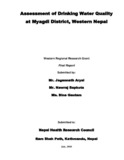Please use this identifier to cite or link to this item:
https://hdl.handle.net/20.500.14356/394| Title: | Assessment of Drinking Water Quality at Myagdi District, Western Nepal |
| Authors: | Aryal, Jagannath Sapkota, Nawraj Gautam, Bina |
| Issue Date: | Jul-2010 |
| Keywords: | Drinking Water Quality Western Nepal |
| Abstract: | In Nepal drinking water quality is appeared as a great public health concern because is major risk factor for high incidence of diarrheal diseases in Nepal. Water pollution is important and serious issue due to haphazard urbanization and industrialization. The principal reasons of the chemical and bacteriological pollution of drinking water are due to inadequate sanitation, dumping of wastes, poor drainage system and irregular supply of drinking water in the pipeline. Besides that the contamination may be either due to the failure of the disinfections of the raw water at the treatment plant or because of the infiltration of contaminated water (sewage) through cross connection and leakage points. All natural water sources, such as wells, stone spouts and ponds are neither treated nor protected properly. The quality of water has deteriorated due to poor management and no monitoring of water quality. The Government of Nepal gazette the National Drinking Water Quality Standards (NDWQS) in 2005 (2062 B.S) as an effort to take first step towards assuring drinking water quality. The NDWQS requires municipalities to meet the national standards within five years after gazeting. Rural communities have been given a further five years before they have to meet the standards. The primary goal of this research is to analyze the drinking water quality parameters physico-chemical & microbiological in order to ensure that the water is safe for drinking. The greatest problem continues to be the microbial contamination of drinking water supplies. It is a tragedy that infants and young children are the innocent victims of the failure to make safe drinking water and basic sanitation services. The major challenge is to access whether the water from different existing sources is safe for drinking or not. The assessment of drinking water scientifically is mandatory to detect whether water is safe for drinking or not. In the present study, a total of 84 water samples were collected from 11 sources, 5 reservoirs and 68 taps water were collected from 9 different wards of Arthunge, VDC and tested physio-chemical and microbiological parameters. The values for majority of the physico-chemical parameters for tested water samples from sources, reservoirs and taps were found to lie within the NDWQS-2062. The physical and chemical analysis performed on water samples indicates clearly that water does not have any significant effect on physico-chemical characteristics of water except pH, because all parameters remains nearly constant over the experimental period. After testing the physico-chemical parameters of water were satisfactory. Most of the parameters checked were found in safe limit except pH and Arsenic. The water samples 54 % have found Arsenic concentration exceeded the permissible level given by WHO (0.01 mg/L), but according to NDWQS-2062 all water samples were near constant with permissible level (0.05 mg/L). The statistical analysis through paired t-test revealed that physic-chemical parameters of drinking water for Tap water samples in winter (January, 2010) and summer (June, 2010) was not differ significantly at 5% level of significance. Microbial analysis performed on water sample was not safe for drinking purpose. There were a number of coliform present in most of samples but there was absence of E. coli. While most of the tested waters were found to be higher number of coliform organism especially in tap water which was not safe for drinking. The microbiological contamination was not great in source and reservoirs were unlikely to represent a public health concern. But in tap water it was found that about 71% of water samples found very high risk due to present of coliform organism. All of samples water tested complied fully with NDWQS-2062. The presence of coliform bacteria in the tap water may be due to contamination in pipelining system, back siphoning, and discontinuity in water supply pattern. Also carelessness may be the reasons for contaminated with coliform. There should be regular monitoring of bacteriological quality of water in order to ensure safe drinking water. Diarrheal diseases may be outcome due to unsafe drinking water. Ministry of Health and Population should develop effective strategy to undertake public health concern ensuring better water quality. |
| URI: | http://103.69.126.140:8080/handle/20.500.14356/394 |
| Appears in Collections: | Post Graduate Grant (PG) Reports |
Items in DSpace are protected by copyright, with all rights reserved, unless otherwise indicated.

